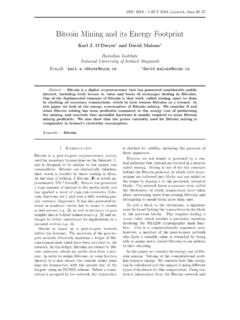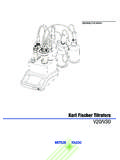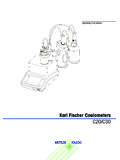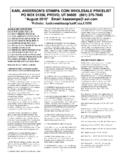Transcription of Karl E. Weick, Kathleen M. Sutcliffe and David Obstfeld
1 44 Organizing for High Reliability: Processes of Collective MindfulnessKarl E. Weick, Kathleen M. Sutcliffe and David ObstfeldSource: Sutton and Staw (eds), Research in Organizational Behavior, Volume 1 (Stanford: Jai Press, 1999), pp. 81 reliability organizations (HROs) are harbingers of adaptive organizational forms for an increasingly complex environment. It is this possibility that warrants an effort to move HROs more centrally into the mainstream of organizational theory and remedy the puzzling state of affairs identifi ed by Scott in the epigraph.
2 Stated summarily, HROs warrant closer attention because they embody processes of mindfulness that suppress tendencies toward inertia. The fact that HROs are seldom portrayed this way or used more widely as templates for organizational design is due partly to their seeming exoticness and partly to uncertainty about how they might generalize to organizations that operate under less trying conditions. We will argue that HROs are important because they provide a window on a distinctive set of pro-cesses that foster effectiveness under trying processes found in the best HROs provide the cognitive infrastructure that enables simultaneous adaptive learning and reliable performance.
3 A focus on these processes represents a theoretical enrichment of previous discussions on the origin and context of organizational accidents ( , Perrow, 1984) which have been framed in a largely macro-level, technology-driven structural perspective. The en-richment arises from the fact that, by explicating a set of cognitive processes that continuously reaccomplish reliability, we supply a mechanism by which reliable structures are enacted. This mechanism is often underdeveloped in non-HROs where people tend to focus on success rather than failure and effi ciency rather than reliability.
4 We suspect that failures in process improvement programs built around reliability ( , Total Quality Management) often occur because the cog-nitive infrastructure is w i l l c o n s t r u c t t h e a r g u m e n t t h a t p r o c e s s e s a s w e l l a s c o n s e q u e n c e s d i s -tinguish HROs in the following manner. First, we sample the existing literature on HROs to establish the eclectic nature of the data base, the limited range of concepts imposed so far on these data, and the reasons why this literature has not had more impact on mainstream organizational theory.
5 Given this background, we then take a closer look at bridges between HROs and traditional organizational theory afforded by the concepts of reliability and mindfulness. We then move to the heart of the analysis and argue that organizing for high reliability in the more effective HROs, is characterized by a preoccupation with failure, reluctance to simplify interpretations, sensitivity to operations, commitment to resilience, and underspecifi ed structuring. These processes reduce the inertial blind spots that allow failures to cumulate and produce catastrophic outcomes. The analysis con-cludes with a discussion of the implications for organization theory and challenges of crisis managementConceptual BackgroundThe Concept of High ReliabilityWhen people refer to HROs they usually have in mind organizations such as nuclear power-generation plants ( , Marcus, 1995; Bourrier, 1996), naval aircraft carriers ( , Rochlin, LaPorte, & Roberts, 1987), air traffi c control systems ( , LaPorte, 1988), and space shuttles (Vaughan, 1996), to list some examples.
6 When we describe processes used in effective HROs, we have in mind cognitive processes found in better nuclear power plants, nuclear aircraft carriers, and the air traffi c control system. These three settings constitute our default referent when specifi c studies are not available to illustrate the precise contrast we are making between effective and ineffective practice. Diverse as HROs may seem, we lump them together because they all operate in an unforgiving social and political environment, an environment rich with the potential for error, where the scale of consequences precludes learning through experimentation, and where to avoid failures in the face of shifting sources of vulnerability, complex processes are used to manage complex technology (Rochlin, 1993).
7 There is considerable variation among high hazard organizations in these qualities as is evident in the fact that many of them are known by their failures to remain reliable ( , Bhopal, Chernobyl, Exxon Valdez). However, we intend to focus on commonalities in the better ones rather than variation to highlight a distinctive perspective on reliabil-ity that these organizations share in theory, if not always in literature on HROs that behave under very trying conditions (LaPorte and Rochlin, 1994, p. 221), thus the data base available to us for analysis, consists of an eclectic mix of case studies involving effective action ( , Diablo Canyon in Schulman, 1993b), limited failure ( , Hinsdale telephone switching center fi re in Pauchant, Thierry, Mitroff, Weldon, & Ventolo, 1991), near catastrophes ( , Three Mile Island cited by LaPorte, 1982), catastrophic failures ( , Te n e r i f e d i s a s t e r i n W e i c k , 1 9 9 0 b ) , a n d s u c c e s s e s t h a t s h o u l d h a v e b e e n f a i l u r e s ( , nuclear weapons management in Sagan, 1993).
8 Existing analyses of these cases tend to emphasize structure and technology rather than process; activities involving anticipation and avoidance rather than activities involving resilience and containment; more focus on interorganizational macro levels of analysis than on micro group levels of analysis; more concern with fatalities than with lasting damage in other domains such as reputation, legitimacy, and survival of the social entity; and more implied comparisons with traditional trial and error organizations than with other high reliability organizations where the fi rst error is the last least two streams of work have addressed organizing around high hazard technologies within organizations Normal Accidents Theory (NAT) and High Reliability Theory (HRT).
9 NAT is based on Perrow s (1984) attempt to translate his understanding of the disaster at Three Mile Island (TMI) into a more general formulation. What stood out about TMI was that its technology was tightly coupled due to time-dependent processes, invariant sequences, and limited slack. The events that spread through this technology were invisible concatenations that were impossible to anticipate and that cascaded in an interactively complex manner. Perrow hypothesized that any system in which elements were tightly coupled and interactively complex would have accidents in the normal course of weick, Sutcliffe and Obstfeld organizing for high reliability 33operations precisely because of this combination of lack of control and inability to comprehend what was happening.
10 These systems include aircraft, chemical plants, and nuclear power plants. He argued that a change in either dimension from tight to loose coupling, or from an interactively complex to linear transformation system would reduce the incidence of catastrophic also considers high-risk technologies but focuses on a subset of high-risk organizations, high reliability organizations, that take a variety of extraordinary steps in pursuit of error-free performance ( , Weick, 1987; Roberts, 1990; Rochlin, 1993; Schulman, 1993a, 1993b; LaPorte, 1994). Some of the necessary but not suffi cient conditions that HRT emphasizes are a strategic prioritization of safety, careful attention to design and procedures, a limited degree of trial-and-error learning, redundancy, decentralized decision-making, continuous training often through simulation, and strong cultures that create a broad vigilance for and respon-siveness to potential accidents (LaPorte & Consolini, 1991; LaPorte, 1994).







